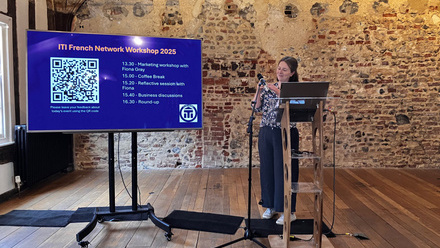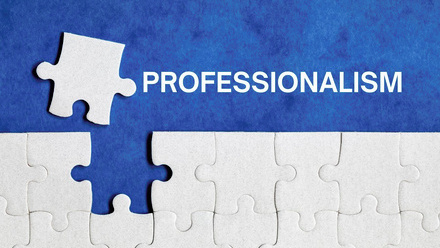To CPD or not to CPD?
Kirsty Heimerl-Moggan never expected to end up with so many different CPD options. She suggests strategies that can help make the right choices.
When I first started interpreting (which, fair enough, was nearly three decades ago) the continuing professional development (CPD) landscape was more like a desert. That is, if you compare it with now.
CPD in those days tended to follow a certain pattern. One: it always involved travelling to a venue (in my case normally from Manchester to London). Two: the CPD events relating to interpreting were generally organised by membership organisations. Three: it always cost me quite a bit of my hard-earned cash.
If the CPD was hosted by a professional body and was free for members, it would still cost me the train journey, subsistence and all the other incidentals that you end up spending on along the way. But more often than not, the event itself cost too. So as this was one of the main ways of networking and meeting colleagues (yes, I am going back far enough for social media not to have ‘been on the scene’ the way it is now), a not unsubstantial part of my income each year was dedicated to these events.
An unprecedented dilemma
You might be wondering: why is she telling me this? Well because the quandary in which I now find myself is something I could never have dreamed of back then! Earlier this year I was faced with the dilemma (or luxury) of two interpreting summits within weeks of each other, both free and with some of the top trainers and interpreters in the business. At the same time there was some great CPD on offer from many of our professional bodies in the UK, the US and Germany.
Free and really interesting CPD kept popping up in my LinkedIn and Twitter networks, there were suddenly lots of great-sounding practice groups for interpreters… and I realised that trying to be part of all this while continuing to do my actual interpreting work was becoming quite stressful!
I realised I would not be able to participate in the summits live, so I signed up for the ‘paid package’ of the first summit and took my time watching the recordings. It was well worth it.
But this whole experience of ‘CPD overload’ made me realise that, tempting though it may be, I can no longer attend all of the CPD my memberships of professional interpreting bodies provide me with, nor the offerings from tech providers, and all the other wonderful forms of CPD which are on offer. Even if it feels as if I have suddenly entered the CPD equivalent of the land of milk and honey, I’ve got to make some choices.
Devising a coping strategy
It was clear: I needed a strategy! I know some of this might seem obvious to many readers, but working one out helped me learn to prioritise again.
Step 1: What do I want to achieve?
Rather than looking at all the CPD on offer, I took a step back and looked at what I wanted to achieve professionally. I used the ITI CPD record categories as a starting point for this: business skills, interpreting skills, language skills, mentoring, professional contribution, subject knowledge, technology skills. I took out translation (as I don’t do it) and ‘other’ (because I had enough areas to cover already). This was quite an eye-opener as I realised that my CPD had become a bit lopsided. I also realised I’d lost track of some areas of CPD which I used to really enjoy.
To take just one example: professional contribution. On closer inspection my recent CPD was all ‘take’ and very little ‘give’. I had contributed one webinar to ITI’s Interpreters’ Development Network on medical interpreter preparation but not really much else (and there was no way I could just blame Covid for this!). Sadly, mentoring didn’t feature on my recent CPD at all either. I say ‘sadly’ because mentors played a massive role in helping my interpreting career take off.
So, after some (slightly painful) self-reflection I realised that I needed to put some balance into my slightly skewed CPD. I also realised that I was not going to be able to cover everything all of the time, which led to my next tactic.
Step 2: Set annual CPD priorities
I decided that picking two CPD areas each year was probably enough. One of those should come from the ‘taking’ and one from the ‘giving’ column. For this next year this meant that I would focus on my business/professional skills (take) and mentoring (give). Next year I will be focusing on my language skills (take) to counteract language attrition setting in, and I’ll make some professional contributions (give).
Of course, this would narrow down my selection somewhat, but I was still struggling with the amount of CPD on offer. So, I resorted to what I love doing most when I am trying to get organised – I made a list.
Step 3: Take stock to help the planning process
This last year of Covid lockdown meant that I had had time to do a lot more CPD than normal across the different types of interpreting I do: conference interpreting, business interpreting and legal interpreting. I was lucky that my work had not dried up, but the time I would normally spend travelling, meeting friends, and visiting family was now available for CPD. Of course, this was not going to be sustainable.
I had not found everything I did useful either, so I decided to list the CPD I had done and evaluate it, which was something I had never really taken the time to do before. It left me with some preferred types of CPD, some good trainers or trainer teams and some self-guided options.
Step 4: Copy (or should that be borrow?)
I am lucky to be part of the ITI Professional Development Committee, and discussions that we had been having in that particular group made me realise that some of my colleagues were going about their CPD very differently from the way I was. Talking to colleagues around you will give you the same insight – both working in your language combination and other languages.
So, the next step was to find out what others were doing for CPD and how they were doing it. How were they setting priorities? Why were they choosing a particular approach/ offering? This was so enlightening, and I realised that I had become almost like a binge eater when it came to CPD, and wanted to attend everything on offer.
However, I was not taking time to evaluate what I had done and draw benefit from it. One colleague actually did a little write-up after any CPD they attended with the pros, cons, takeaways/ learning followed by to-do action points. I, in turn, was not even finding the time to fully complete my ITI CPD log – I tended to stop at the point of asking myself the ‘what did you learn?’ question, and the thinking about ‘future development’ notes.
This analysis made me realise that I was making myself miss out on some of the benefits of CPD: that is, the reflection and letting what I had learned sink in and so on.
I was also finding that so much of the CPD my colleagues (both interpreters and translators) were doing was in areas I had never thought of. My focus had been purely on interpreting, language and business skills. What I had not considered was undertaking training that was actually meant for my target audience – my client – even though this can be invaluable. So, recently I participated (and successfully completed) a Client Contractor National Safety Group (CCNSG) Health and Safety training course, which has been extremely useful for my interpreting work in this area. In fact, funnily enough, taking time to copy from colleagues seemed like the best CPD I had done in a long time.
So, in conclusion, I have decided not to let my impostor syndrome get the better of me by making me cram onto my schedule as much CPD as humanly possible. Instead I now aim to start thinking through my CPD using those steps:
Step 1: What do I want to achieve?
Step 2: Set annual CPD priorities
Step 3: Take stock to help the planning process
Step 4: Copy (or should that be borrow?).
I look at these in conjunction with ITI’s CPD categories:
1. Business skills
2. Interpreting skills
3. Language skills
4. Mentoring
5. Professional contribution
6. Subject knowledge
7. Technology skills
8. Translation skills
9. Other.
I also plan to remember that if I discover anything new, anything that particularly addresses an identified shortcoming, such as a lack of knowledge, or an area of vocabulary I am missing, then I can adapt and tweak.
My CPD plan is now no longer a deluge of crammed-in events but a path (albeit sometimes a winding one) that helps me move forward. Most of all, I want to make sure I enjoy what I am learning and never lose sight of the fact that any CPD – no matter how small or large or strange – is helping me become a better professional.
This article first appeared in the November/December 2021 edition of ITI Bulletin.






